|
|
ADDRESS AT THE 3rd ANNUAL COMPUTER LITERACY EXCELLENCE AWARDS FOR THE YEAR 2005, VIGYAN BHAVAN, NEW DELHI
07-12-2005 : New Delhi
Capacity building in Education
I am indeed delighted to participate in the 3rd Annual Computer Literacy Excellence Award for Schools - 2004 organized by the Ministry of Communication & Information Technology. I greet the organizers, educational planners, principals, teachers, students and other distinguished guests. I congratulate the award winners for their excellent work in attaining and imparting computer literacy. Today I would like to discuss on the topic ?Capacity building in Education?.
Promoting Computer Literacy across the country
When I was studying the list of awardees for the year 2004, I am happy that, I find schools located in remote areas such as Bari-yahi in Bihar, Lkhel in Kohima, Bari in Madhya Pradesh, Hanuman Ghatt in Rajasthan, Padalur in Tamil Nadu and Moldhar in Uttaranchal have been selected for the award. This trend of reaching remote areas of the state should spread further since ICT is a great leveller of disparities and the bandwidth democratises access to information. But at the same time, I found that there are no nominations from the States of Arunachal Pradesh, Assam, Himachal Pradesh, J & K, Jharkhand, Meghalaya, Orissa, Punjab and the Union Territories of Dadra and Nagar Haveli, and Daman and Diu. I would suggest the Ministry of Information and Communication Technology in collaboration with Ministry of Human Resource Development to work with the State Governments to improve the computer literacy programme across the length and breadth of the country.
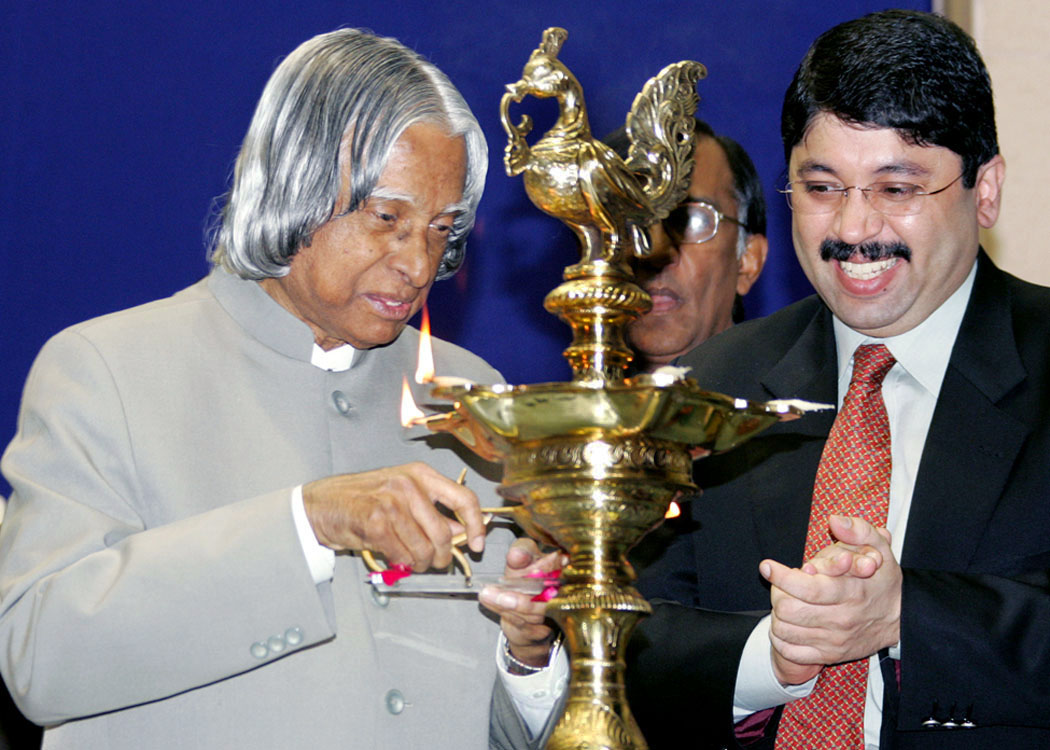
Computer literacy should not be restricted only to the usage of computer. What is needed is the provision of learning tools such as comprehensive e-learning packages on various subjects with illustrations to make the learning interesting and productive. Also, the students must be given opportunity to work on certain projects on the computer with an access to Internet which will reinforce the learning and enable them to enhance the learning capacity and knowledge. It is essential to make the student an active partner in the teaching and learning process. Now I would like to discuss a relevant experience of computer literacy in Kerala.
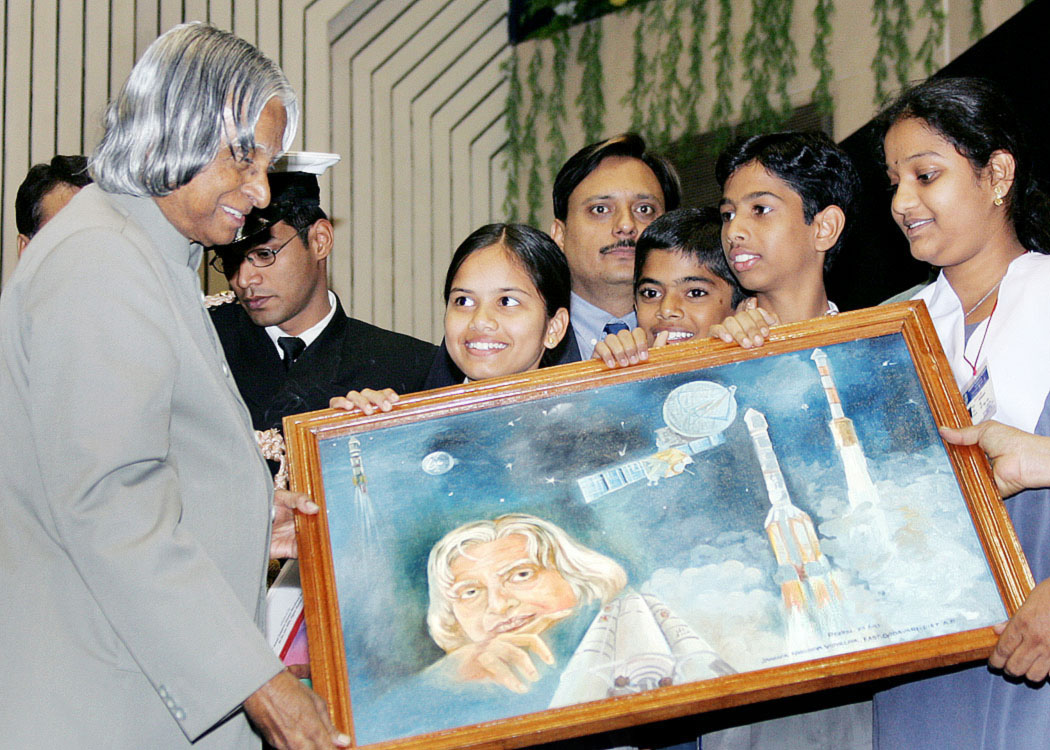

Kerala Experience
During the year 2002 in Malappuram District Kerala it was found that a large number of people working in the Gulf were returning home since the Gulf countries were replacing Indian employees with local people. The District Panchayat of Malappuram wanted to find a method by which the incoming people are trained productively so that they can get alternative employment. This resulted in the District Panchayat, Gram Panchayat and the Municipalties of Malappuram District planning a computer literacy programme by contracting a computer company. When this plan was mooted, the IT Department of Kerala Government thought that this could be taken up as a electronic and knowledge connectivity component of the PURA programme. Based on this thought, local entrepreneurs were asked to create computer kiosks in different villages in the State. Overall, four hundred and fifty five kiosks were setup for providing the training to nearly six lakh members. As per the plan, computer literacy training was to be provided to, at least one member in each family. The programme was basically to make the member feel confident to use the computer and be in a position to read the mails and respond. A total of Rs. 7 Crore. was spent on this project. The fund has been provided by the State Government, District Panchayat Boards and the individual. In addition, around sixty thousand people received more advanced computer training through a collaborative programme organized by Kerala State Governments in association with Computer Society of India. The entire programme was completed in two years time. Many of the people trained in the second phase could easily get employment. This programme enhanced the self-esteem of the parents who were earlier illiterates and their children started respecting them. Also the programme enabled the parents to understand the computer terminology such as mouse, virus etc. The average cost incurred per candidate for training is just Rs. 100. This is an example of providing cost effective hassle free network through public private partnership for the training of the rural citizens. This training has transformed the outlook of the families of Malappuram. The connectivity provided is being used for e-banking, maintaining communication with families abroad, conducting spoken English and Arabic typewriting classes, downloading new embroidery designs to help their clothes to fetch higher price, e-krishi and efficient governance. This programme is being replicated in six other districts of Kerala. Novel programme like this are worth emulating. Now I would like to discuss the actions needed to be taken to spread the technology enhanced education, operation and the way of life.
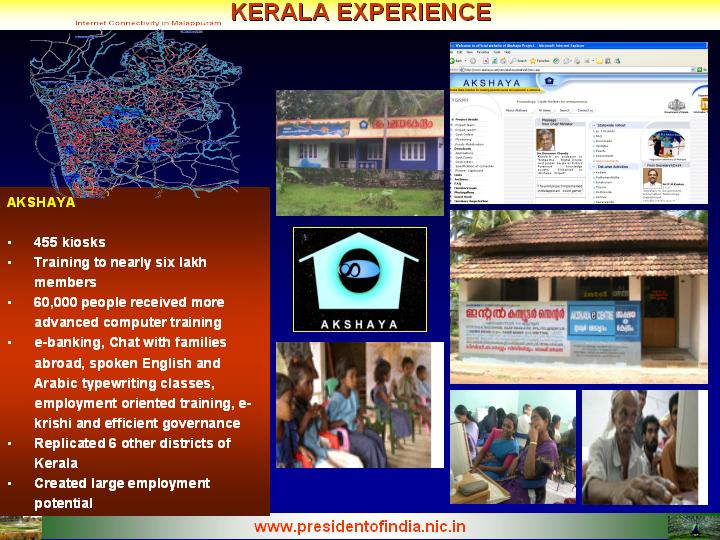

Smiles of Children
I would like to share two observations relevant to this audience. When you look at small children, they are always smiling. When they start going to primary school and carry a big bag on their shoulders, the smile reduces. When they reach the secondary school, the smile further reduces. During higher secondary course, the smile virtually vanishes. When they enter college, they become more serious and after completing the college they are in a state of big worry. Simultaneously, during this period, the concerns of what is in store next linking financial situations and the competitiveness involved in entering into the specific field dominates the mind of the children and parents. This is the situation which we all have to overcome. Can we make an education system, which will retain the smile on the faces of our children right through the period of their education till they take up a job as they start attending the school? Is it possible? This can come if we make the education system creative throughout and provide full employment opportunity to all the youth based on their aptitude and capability. This creativity can come by reducing the theoretical burden in the primary level, progressively increasing the theory in the secondary and finally leading to higher level teaching and create self-reliance among individuals to undertake entrepreneurship and be an employment generator rather than employment seeker.
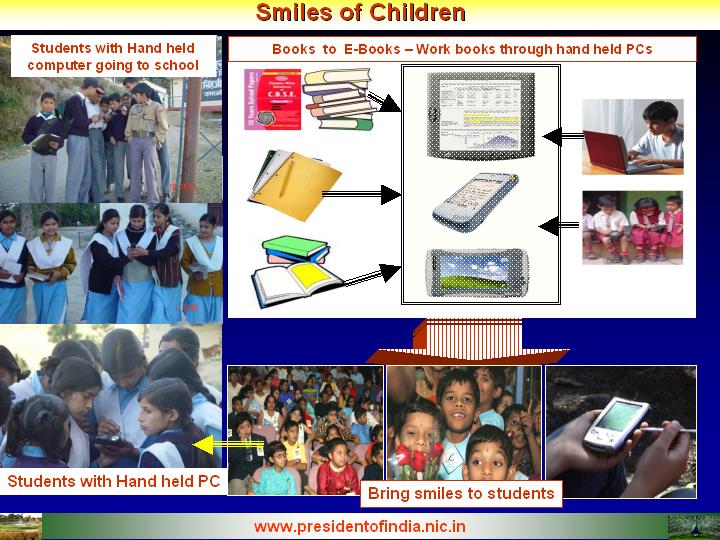
The education system has three phases of learning such as primary, secondary and higher education. We discussed just now the necessity of ?Entrepreneurship integrated Education? for the secondary and higher education, whereas the primary education is intended to bring out the creativity of the children. This is possible only through good teachers teaching children up to the age of 14, which covers nearly 23% of the population. India particularly needs large amount of teachers, all at a time to provide education to nearly 400 million students for the primary, secondary and higher education.
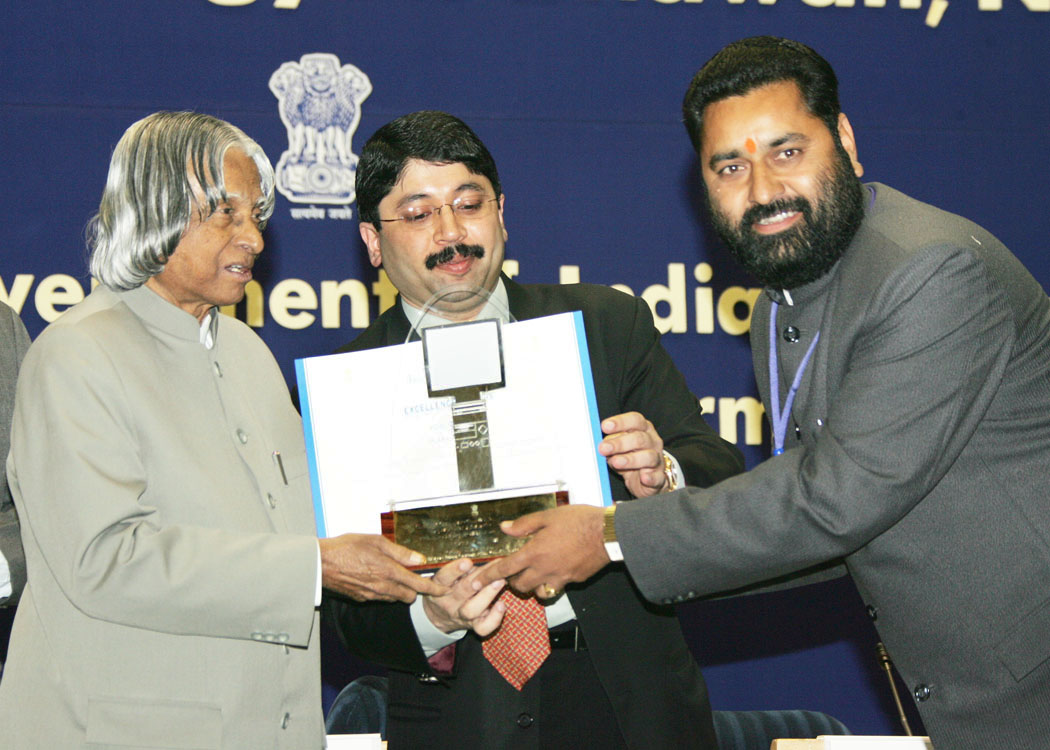
Our schools both in urban and rural areas have a problem of having experienced teachers. Per capita availability of teachers is also very low. I have seen classes are loaded with 60 to 80 children with one teacher. It is impossible for a teacher to pay attention to each student in the available 40 minute period in a class. This results in dilution of the quality and non recognition of creative students, some times leading to, drop outs. We have to see how technology can assist in overcoming these problems. We need to bridge this gap by providing technology tools, connectivity and content with quality teacher, which will create and maintain the interest of the students in the learning process. To enable the above, I would suggest the following course of action.
Cost effective Handheld PC: Students carry the big school bag containing lot of books and note books on their shoulder. Can ICT find a solution to this through a cost effective hand held computer which can be loaded with all the text books as e-books, note books as e-notebooks and e-workbooks and become a self learning tool for our children?
Recently we in Rashtrapati Bhavan undertook an exercise with a tablet PC available in the market at around $800. We have loaded the Linux operating system, and designed an e-book, e-notebook loaded with digital library books and connected to our e-learning portal. With this tablet PC, I can collaborate with my officers, scientists, use as a note book, use internet, use the white board and it can work with all the systems in an integrated mode. I can carry this device in my hand and take notes anywhere. Based on this experience, I would suggest, Ministry of Human Resource Development and Ministry of Communication and Information Technology (MCIT), R&D Organizations and Private Industries to launch a programme to design, develop a hand held device with the power I mentioned earlier at a cost of $100 to $250 (Rs. 5000 ? 12,500) per handheld tablet PC. This will definitely be possible, since the number of tablet PCs required in our country for the students will be in millions. Rashtrapati Bhavan can certainly share our experience. Economy of scale will bring down the cost. This will not only enable the school children to carry just the hand held computer rather than a heavy bag for reading and doing class work, but also be useful for teachers and the other professionals. Once bought, this computer should be useful for the rest of the educational career.
Nodal Centres for tele-education: During the last three years, Computer Literacy Awards have been given to around one hundred and forty schools in different parts of the country. I would recommend that the awardee schools may be made as the nodal centres for promoting computer literacy and computer assisted tele-education system in all the schools of the districts. The nodal centres can be connected to the other schools in the district through Wi-Max and the tele-education package along with the e-learning content. The nodal school can have a small studio invite the best teachers in the district and facilitate transmission of quality teaching on different subjects to all the schools of the district as per the mutually agreed schedule. This will enable equitable access of quality teaching to all the schools in the rural areas. This model is already functional in five village knowledge centres of the Periyar PURA villages and the content being provided by staff and students of Periyar Maniammai Women Engineering College, Vallam. Rashtrapati Bhavan has a link to these PURA Villages. This connectivity is also providing knowledge connectivity between agriculture specialists and farmers, doctors and patients, craftsmen / artisans / technicians and self-help groups. For providing this type of connectivity, the Sarva Siksha Abiyan programme can assist.
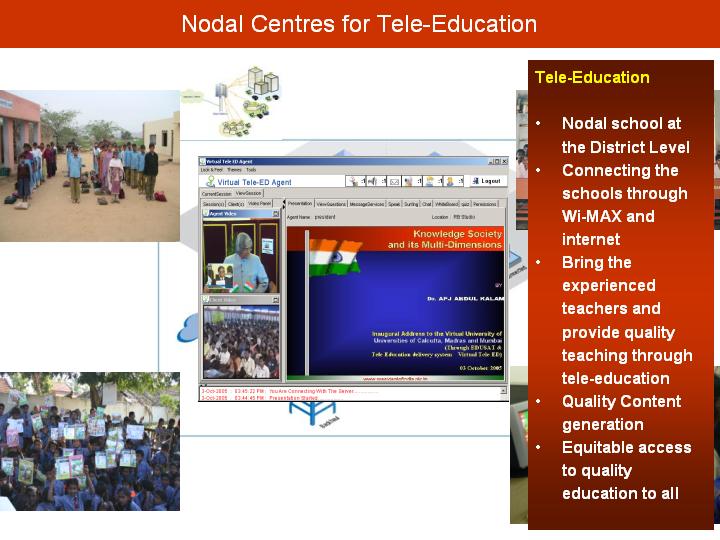
E-learning Content: Experience - To enhance the learning process of the students of ?Sarvodhya School? located in President?s Estate, on 13 Oct 2005, I inaugurated the e-learning centre established by us. This provides 3D based animated lessons covering the CBSE Syllabus of Science and Mathematics for classes starting from 1st std to Class 12th std. When I went for inauguration the students were so enthusiastic, they started experimenting with the terminal even without training. One of the students showed me how an atom works in the fusion process. Another student showed how he is able to solve a differential equation and understands the physics and mathematics better. The school is now arranging to schedule the study periods for all classes regularly so that the benefit of computer assisted education reaches all the students equitably. It is also being planned to make the facility available for other students residing in the President?s Estate during the non school hours and holidays. This e-learning software is also available in our Rashtrapati Bhavan Library and Children?s Art Gallery, so that the children can make use of it during their visits. I would like to present some of the sample multi-media content of e-learning so that you can all appreciate the power of the e-learning tools.
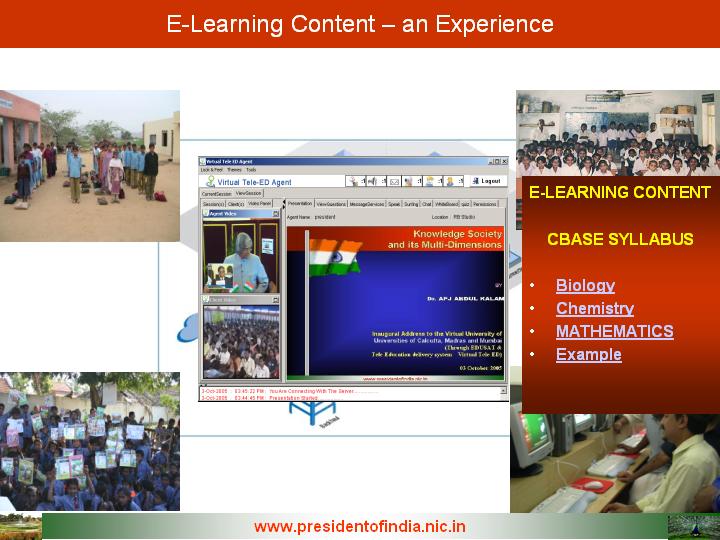
So far I have discussed the need for the integrated mission in providing cost effective computer, quality teaching through tele-education connectivity to reach out large number of schools and the quality e-learning content. This integrated mission will certainly provide an equitable access of quality education to the millions of students of our nation and reduce the drop outs in a big way.

Can we Use ICT to collaborate
The schools that have been identified for the award today, I am sure, will have some of the excellent teachers. There are many such schools across the country which have been bestowed with at least one or more very good teachers. They should develop the learning materials and make them available to every child across the country free. For this, I suggest that between the Ministry of Communication and Information Technology and the Ministry of HRD, we should identify the syllabi for each course in each class and request at least 10 teachers for every subject to develop the e-learning material to a specific format and pedagogy. We then should select the either best course material or the best combination of best of breed solution. The subjects can be made very interesting through stories, cartoons and even games. In this regard, I would like to give an example of one of the Professors of Indian origin who had revoltionized the understanding of Computer Security by children using innovative stories and games. Prof Pradeep Khosla is the Dean of the Carnegie Institute of Technology. The portal where you can find the simple way of teaching children about Information security through games is http://www.mysecurecyberspace.com/game
Today, India and many other countries are probably well developed when it comes to Libraries and Lectures, but are far behind in the creation of virtual laboratories due to the lack of adequate bandwidth at affordable cost. This situation has to be remedied. Without waiting for the bandwidth to be available, the teachers and technologists should develop simple experiments that can be performed on the web. For example, the titration experiment that we do in chemistry classes can be done virtually and almost real life like with out having to waste chemicals- the chemical reactions, the opening of the pitot tube, the colouring of the resultant chemical in the reaction can be made to look real. With this every remote school can do any experiment in chemistry ? even those involving expensive chemicals. This can also be done for almost all experiments in Physics involving dynamics, understanding of Newton?s laws, experiments in light, optics just to name a few. This revolution in taking experiments to the web would complete the E-learning process in India.
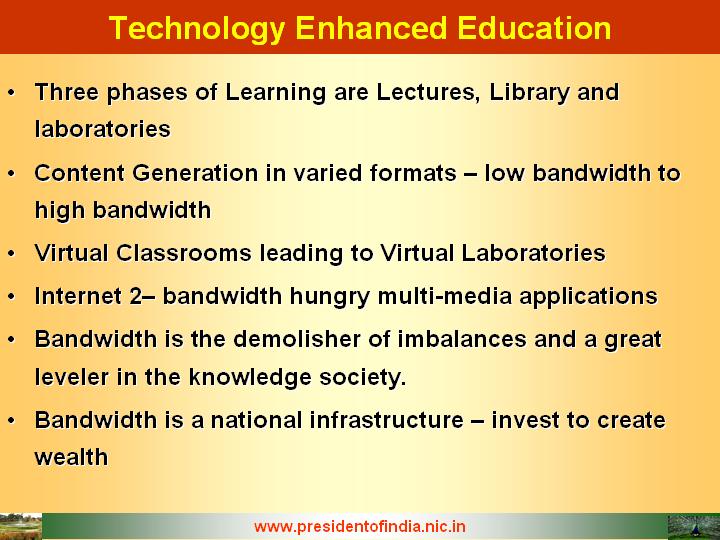

Conclusion: Technology enhanced education
The three phases of learning are the lectures, library and laboratories. They require increasing bandwidth from a few 100?s of kilobytes for the lectures to a few megabytes for the formal digital libraries and the informal world of knowledge from the Internet, to gigabits of connectivity for remote laboratories in the world of high precision science and engineering. As the bandwidth becomes cheaper and available in abundance, universities, institutions should be able to run remote instruments and facilities as complex as NMR to Wind tunnels and the schools can have their virtual laboratories connected with the R&D institutions. This will ultimately provide equitable access to the entire education system beyond just the lectures and the lecturers. Thus the bandwidth is the demolisher of imbalances and a great leveler in the knowledge society. At the same time, content generation is essential need for enriching the education.
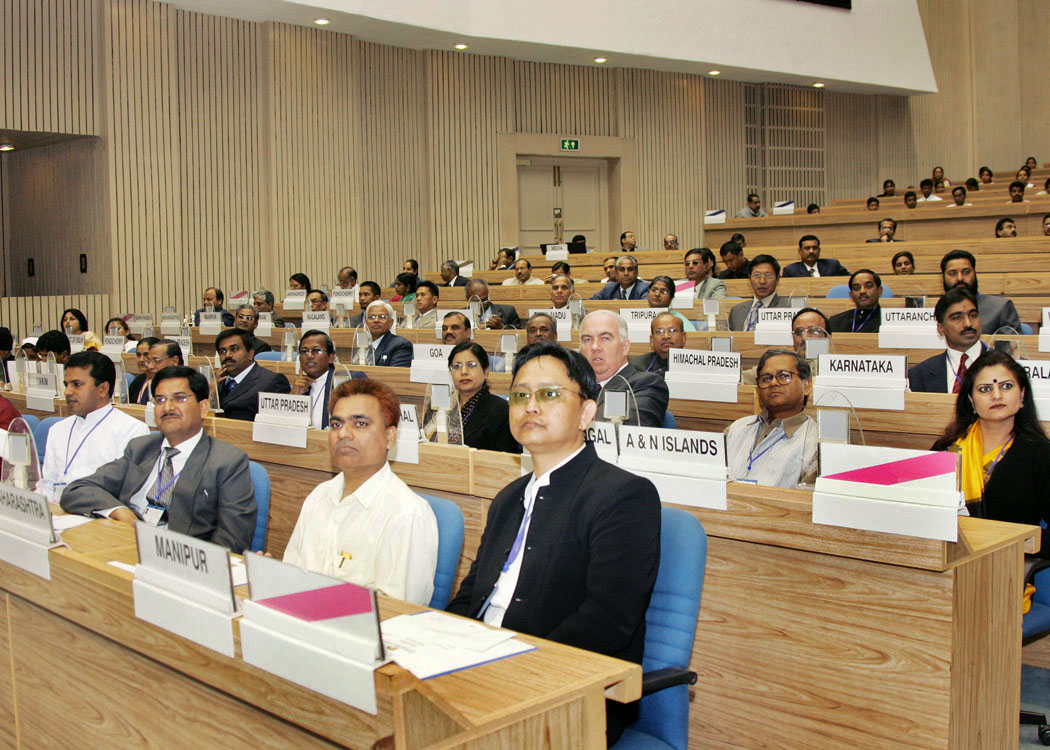
It is important to connect the learning centres using high bandwidth connectivity because, during the lectures, the teachers has to push the lessons, internet reference, pages from the text books and multimedia based animated scenes, videos and audio to a live virtual class room. Many nations have moved to a fast internet2 high bandwidth applications. The time has come for our country to make the high bandwidth available for the nation including the teaching institutions.
To make the country the most advanced knowledge society, we should aim at making the bandwidth available without hindrance and at no cost. Making the bandwidth available is like the Government laying the roads. Movement of materials through these roads creates wealth in the industrial economy and the government recovers more than the investment on the roads by way taxes and enhanced prosperity of its people. In the modern digital economy driven by knowledge products, bits and bytes traverse the network and create wealth and this will recover the cost of investments in the bandwidth.
Once again my congratulations to all the winners of the computer literacy award and my best wishes to the Ministry of Information and Communication Technology in their mission of promoting quality education through technology.
May God bless you.
<<Back
|
|